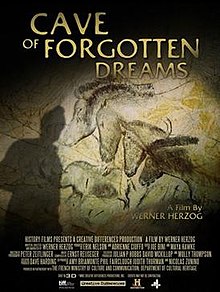Cave of Forgotten Dreams
| Cave of Forgotten Dreams | |
|---|---|
 |
|
| Directed by | Werner Herzog |
| Produced by | Erik Nelson Adrienne Ciuffo Dave Harding Julian Hobbs David McKillop |
| Written by | Werner Herzog |
| Narrated by | Werner Herzog |
| Music by | Ernst Reijseger |
| Cinematography | Peter Zeitlinger |
| Edited by |
Joe Bini Maya Hawke |
|
Production
company |
|
| Distributed by |
IFC Films Sundance Selects |
|
Release date
|
|
|
Running time
|
89 minutes |
| Country | Canada United States France Germany United Kingdom |
| Language | English |
| Box office | $6,467,348 |
Cave of Forgotten Dreams is a 2010 3D documentary film by Werner Herzog about the Chauvet Cave in southern France, which contains the oldest human-painted images yet discovered. Some of them were crafted around 32,000 years ago. The film premiered at the 2010 Toronto International Film Festival and consists of images from inside the cave as well as of interviews with various scientists and historians. The film also includes footage of the nearby Pont d'Arc natural bridge.
Herzog's interest in the Chauvet cave was prompted by Judith Thurman's New Yorker article "First Impressions". Thurman is listed as one of the co-producers of the film.
The cave is carefully preserved and the general public is not allowed to enter. Herzog received special permission from the French Minister of Culture to film inside the cave. Having received permission, Herzog nonetheless had to film under heavy restrictions. All people authorized to enter must wear special suits and shoes that have had no contact with the exterior. Also, because of near-toxic levels of radon and carbon dioxide, nobody can stay in the cave for more than a few hours per day.
Herzog was allowed to have only three people with him in the cave: the cinematographer Peter Zeitlinger, a sound recorder (Eric Spitzer-Marlyn), and an assistant. Herzog himself worked the lights. The crew was allowed to use only battery-powered equipment they could carry into the cave themselves, and only lights that gave off no excess heat. The 3-D cameras were custom-built for the production, and were often assembled inside the cave itself. Herzog was allowed six shooting days of four hours each. The crew could not touch any part of the cave's wall or floor, and were confined to a 2-foot-wide (0.61 m) walkway.
The production encountered several technical difficulties in working with the 3-D cameras in a documentary setting. At the time of production, 3-D films were typically shot on stages with heavy use of digital manipulation. Often, foreground and background elements would be shot separately and digitally composited into the finished shot. Techniques for 3-D filmmaking in natural environments with a single camera and no compositing were largely undeveloped, and had to be worked out experimentally by the crew in post-production.
...
Wikipedia
